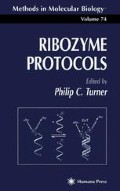Abstract
Ribozymes first bind their target via complementary sequences like a conventional antisense strand and, subsequently, catalyze the hydrolyses of the cleavable motif. In the case of hammerhead ribozymes, this is a specific base triplet. Even though it has been described that there are 12 conceivable motifs recognized by hammerhead ribozymes that are cleaved with different efficiencies (1,2), a typical long-chain target RNA provides a large number of potential cleavage sites. Given this flexibility, one important step in ribozyme design is the selection of an appropriate cleavable motif within the target. For ribozyme-mediated inhibition in living cells, the contribution of antisense effects and catalytic effects to the overall extent of inhibition remains unresolved, and may well be dependent on the specific constructs and biological systems. However, it is reasonable to assume that the first step, the binding of the ribozyme with its target, is crucial. Therefore, the local target sequence against which a ribozyme is directed does not only have to contain a cleavable triplet, but should also be accessible for the ribozyme.
Access this chapter
Tax calculation will be finalised at checkout
Purchases are for personal use only
References
Shimayama, T., Nishikawa, S., and Taira, K. (1995) Generality of the NUX rule: kinetic analyses of the results of systematic mutations in the trinucleotide at the cleavage site of hammerhead ribozymes. Biochemistry 34, 3649–3654.
Zoumadakis, M. and Tabler, M. (1995) Comparative analysis of cleavage rates after systematic permutation of the NUX↓ consensus target motif for hammerhead ribozymes. Nucleic Acids Res. 23, 1192–1196.
Rittner, K., Burmester, C., and Sczakiel, G. (1993) In vitro selection of fast-hybridizing and effective antisense RNAs directed against the human immunodeficiency virus type 1. Nucleic Acids Res. 21, 1381–1387.
Rhodes A. and James W. J. (1990) Inhibition of human immunodeficiency virus replication by endogenously synthesized antisense RNA. J. Gen. Virol. 71, 1965–1974.
Sczakiel, G., Homann, M., and Rittner, K. (1993) Computer-aided search for effective antisense RNA target sequences of the human immunodeficiency virus type 1. Antisense Res. Dev. 3, 45–52.
Devereux, J., Haeberli, P., and Smithies, O. (1984) A comprehensive set of sequence analysis programs for the VAX. Nucleic Acids Res. 12, 387–395.
Senger, M., Glatting, K.-H., Ritter, O., and Suhai, S. (1995) X-HUSAR, an X-based graphical interface for the analysis of genomic sequences. Comput. Programs Biomed. 46, 131–141.
Tabler, M., Homann, M., Tzortzakai, S., and Sczakiel, G. (1994) A three-nucleotide helix I is sufficient for full activity of a hammerhead ribozyme: advantages of an asymmetric design. Nucleic Acids Res. 22, 3958–3965.
Author information
Authors and Affiliations
Editor information
Editors and Affiliations
Rights and permissions
Copyright information
© 1997 Humana Press Inc.
About this protocol
Cite this protocol
Sczakiel, G., Tabler, M. (1997). Computer-Aided Calculation of the Local Folding Potential of Target RNA and Its Use for Ribozyme Design. In: Turner, P.C. (eds) Ribozyme Protocols. Methods in Molecular Biology™, vol 74. Humana Press. https://doi.org/10.1385/0-89603-389-9:11
Download citation
DOI: https://doi.org/10.1385/0-89603-389-9:11
Publisher Name: Humana Press
Print ISBN: 978-0-89603-389-4
Online ISBN: 978-1-59259-560-0
eBook Packages: Springer Protocols

